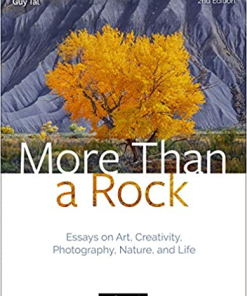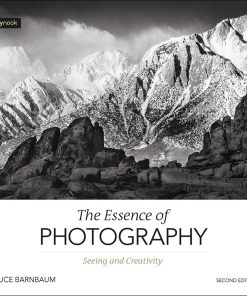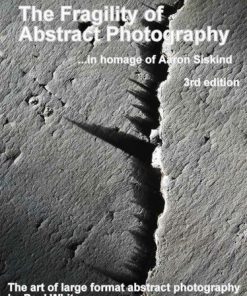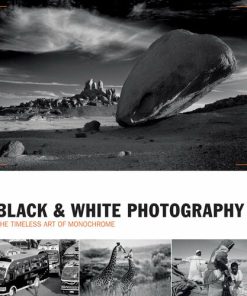The Art of Photography A Personal Approach to Artistic Expression 2nd Edition by Bruce Barnbaum ISBN 1681982102 9781681982106
$50.00 Original price was: $50.00.$25.00Current price is: $25.00.
The Art of Photography A Personal Approach to Artistic Expression 2nd Edition by Bruce Barnbaum – Ebook PDF Instant Download/Delivery: 1681982102, 9781681982106
Full download The Art of Photography A Personal Approach to Artistic Expression 2nd Edition after payment
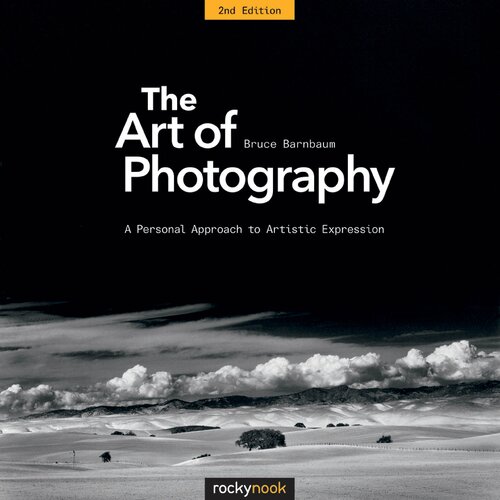
Product details:
ISBN 10: 1681982102
ISBN 13: 9781681982106
Author: Bruce Barnbaum
Without talking down to anyone or talking over anyone’s head, renowned photographer, teacher, and author Bruce Barnbaum presents how-to techniques for both traditional and digital approaches. In this newest edition of the book, Barnbaum has included many new images and has completely revised the text, with particular focus on two crucial chapters covering digital photography: he revised a chapter covering the digital zone system, and includes a brand-new chapter on image adjustments using digital tools. There is also a new chapter discussing the concepts of “art versus technique” and “traditional versus digital” approaches to photography. Throughout the book, Barnbaum goes well beyond the technical, as he delves deeply into the philosophical, expressive, and creative aspects of photography so often avoided in other books.
Barnbaum is recognized as one of the world’s finest landscape and architectural photographers, and for decades has been considered one of the best instructors in the field of photography. This latest incarnation of his textbook—which has evolved, grown, and been refined over the past 45 years—will prove to be an ongoing, invaluable photographic reference for years to come. It is truly the resource of choice for the thinking photographer.Topics include:
- Elements of Composition
- Visualization
- Light and Color
- Filters
- Black-and-White
- The Digital Zone System
- The Zone System for Film
- Printing and Presentation
- Exploding Photographic Myths
- Artistic Integrity
- Realism, Abstraction, and Art
- Creativity and Intuition
- A Personal Philosophy
- And much, much more…
The Art of Photography A Personal Approach to Artistic Expression 2nd Table of contents:
1 Communication Through Photography
Enthusiasm
Judging Your Own Personal Response
2 What Is Composition?
How the Human Eye Sees
Unified Thought
Simplicity
Expressing Your Own Point of View
Simplicity vs. Complexity
3 Elements of Composition
Contrast and Tone
Line
Form
Line, Form, Contrast, and Emotion
Pattern
Balance
Movement
Positive/Negative Space
Texture
Camera Position
Focal Length of Lens and Cropping
Depth of Field
Shutter Speed
Relationships
Involvement with the Scene
Rules, Formulas, and Other Problems and Pitfalls
4 Visualization
Step 1: Photographic Looking and Seeing
Step 2: Composing an Image
Step 3: Envisioning the Final Image
Step 4: Suggested Procedures for Those Having Trouble Envisioning a Final Image
Step 5: Planning a Strategy for a Final Image
How Your Eye Differs from Your Camera
Alternative Approaches
5 Light
Looking at Light
Exercises in Learning to See Light More Accurately
Light Determines Form
Types of Lighting/Quality of Light
Light as Seen by the Eye and by Film or Sensors, and the Inverse Square Law
6 Color
The Color Wheel and Color Sphere
Color Composition
Color Families, Color Contrast, and Their Emotional Effects
Subjectivity and Mood of Color
Working with Color Digitally
Working with Color Traditionally
In Summary
7 Filters
Black-and-White Filters for Film
Examples with a Hypothetical Landscape
Contrast Control with Filters
Infrared Film and Filters
Color Correction Filters for Traditional Film Imagery
Neutral Density and Polarizing Filters
Problems Associated with Polarizers
Digital Polarizing Filter
Digital Black-and-White Filtration
Digital Color Filtration
8 The Zone System of Exposure for Black-and-White Film
A Brief Overview
Film’s Response to Light: Building the Zone System
Translating Negative Densities to Print Tonalities
The Light Meter—How It Works
Review of Negative Exposure Procedure
Using the Zone System to Depart from Reality
The Zone System for Color Negatives
The Zone System and the Inverse Square Law
In Summary
9 Contrast Control and the Extended Zone System for Black-and-White Negatives
Chapter 9 Overview
The Negative During Development
The Bellows Analogy
Putting Higher Zones to Work
Reciprocity Failure
Examples of Decreasing and Increasing Contrast
The Exposure/Density Curve and Zone 4 Shadow Placement
Differences Between Photography and Sensitometry: Texture vs. Tone and Zone 4 Shadow Placement
Developing the Exposed Negative
Explanation of Compensating Development
Two-Solution Compensating Development for Negatives
Development Procedures for Sheet Film and Roll Film
The Zone System and Roll Film
Negative Materials and Developers
10 The Print
Black-and-White Enlarging Papers
Variable Contrast vs. Graded Papers
Fiber Base Papers vs. Resin Coated (RC) Papers
Black-and-White Paper Developers
Making Contact Proof Prints
Preliminary Work Toward a Final Print
Make Test Prints, Not Test Strips
Dodging and Burning
Integrating the Entire Process: Visualization, Exposure, Development, and Printing
Burning with Variable Contrast Papers
Advanced Darkroom Techniques
Inspection, Evaluation, and the Myth of “Dry-Down”
Potassium Ferricyanide Reducing (Bleaching)
Final Fixing of the Image
Local vs. Overall Contrast Control
Scale
Selenium Toning Prints
Other Toners
Chemical Coloration
Full Archival Processing of Prints
Toning, Intensifying, and Reducing Negatives
Cold, Neutral, and Warm Tone Papers
Review of Contrast Controls
Infinite Contrast Control for Black-and-White after Negative Development
Color Printing
The Final Product Is What Matters
Scanning from Film
11 The Digital Zone System
Basics of Digital Exposure
The Sensor’s Useful Brightness Range
Translating Theory to Excellent Digital Exposures
The Histogram—The Heart of the Digital Zone System
The RAW Converter—Processing the RAW Exposure
High Dynamic Range Images—The Extended Zone System for Digital Photography
Converting Digital Color Exposures to Black-and-White
Panoramas and Other Image Combinations
12 Image Adjustments—Using the Digital Tools
The ACR Tool Chest
ACR Summary
The Photoshop Tool Chest
Returning to ACR from Photoshop
Closing Thoughts
13 Traditional, Digital, Art and Technique
Art, Technique, and Their Importance
Choosing Digital or Traditional
Some Closing Thoughts
14 Exploding Photographic Myths
Myth #1
Myth #2
Myth #3
Myth #4
Myth #5
Myth #6
Myth #7
Myth #8
Myth #9
Myth #10
15 Presentation
Dry Mounting Prints
Making Positioning Guides for Print Placement
Spotting, Etching, and Correction of Defects
Print Finishing
16 Photographic Realism, Abstraction, and Art
Photography as Fine Art
Photography and Painting—Their Mutual Influence
Some Personal Examples
The Strength of Abstraction
Inwardly and Outwardly Directed Questions
The Power of Photography
17 Approaching Creativity Intuitively
Intuition in Science
Avoiding Intuition
Understanding and Misunderstanding Intuition
Examples of the Intuitive Approach
Applying Intuition to Your Photography
Conclusion
18 Toward a Personal Philosophy
Flexibility
Visual Arts
Nonvisual Arts
Expanding and Defining Your Interests
Limitations of Photography
Developing a Personal Style
Self-Critique, Interaction, and Study
Appendix 1 Testing Materials and Equipment for Traditional Photography
Appendix 2 Enlarger Light Sources
People also search for The Art of Photography A Personal Approach to Artistic Expression 2nd:
the art of photography a personal approach
what is the art of photography
what are the principles of photography
the art of photography an approach to personal expression
the art of photography article
Tags:
Bruce Barnbaum,Photography,Artistic Expression
You may also like…
Business & Economics - Industries
Biology and other natural sciences - Plants: Agriculture and Forestry
Arts - Photography
Arts - Photography
More Than a Rock 2nd Edition Essays on Art Creativity Photography Nature and Life Guy Tal
Arts - Photography
Business & Economics - Management & Leadership
Not Everyone Gets A Trophy How to Manage the Millennials 2nd Edition Bruce Tulgan
Arts - Photography
Arts - Photography
Black White Photography The timeless art of monochrome 1st Edition Michael Freeman
Relationships & Lifestyle - Diet & Nutrition
Psychologizing A Personal Practice Based Approach to Psychology Patrick M Whitehead







